Last year, Tony was diagnosed with acute lymphoblastic leukaemia (ALL) - and told that he'd need a stem cell transplant to have a chance of life. In this moving two-part story, he tells us about his experiences and his recovery - and his wife Beth reflects on his astonishing decision to take on a lifesaving 75km journey in support of Anthony Nolan.
Tony's story
In 2015, I was diagnosed with acute lymphoblastic leukaemia. If you had told me what was wrong with me just a few weeks before, I wouldn't have believed it. I'd always been so fit and healthy that I still considered myself ‘indestructible'!
However, by the time I actually received the diagnosis I had been so ill for a number of days that I wasn't shocked.
I found the doctors' very matter-of-fact manner strangely comforting, as it felt like my situation wasn't unusual and was something they dealt with every day. It was only afterwards that I began to reflect on the fact that one of the junior doctors was crying as they told me the initial diagnosis! (The consultant also somewhat misleadingly informed us that my chances of survival were only "better than 50%".)
My mind immediately turned to practical aspects – most notably, my wife was on her way to visit me with our children, and I was concerned about how I could best protect them. I was fortunate that there was a bed available at UCLH, and I was transferred that evening from Watford General.
Dealing with my treatment
I immediately got caught up in the treatment process, and in many ways there was little time to dwell on the diagnosis; our focus became the treatment schedule and what I had to do to get better. I knew there were some variables in the future, but within days of diagnosis the first 4 weeks were mapped out.
I put the treatment schedule on the wall, along with lots of photos of my family and drawings my children had done for me, so I had my plan and my motivation in front of me the whole time.
We became known as the couple who asked lots of questions! But we found that getting lots of information and understanding exactly what was happening gave us a sense of control. I tried to keep as much as possible to my normal routine, and focus on the positive outcome.
I was very lucky to have a lot of family and friends to visit me, but it was at times an isolating experience, as all of the patients were in individual rooms. The nurses were fantastic and the best source of information and advice; however it was great to meet up with other patients, as there was generally such a sense of camaraderie and comfort from shared experiences.
During my time in hospital, my wife bombarded me with photos and videos of the children so that I still felt in touch with what was going on at home, and to keep me positive. Around the transplant I went four weeks without seeing my children due to the risk of infection, which was really difficult.
The worst time emotionally was a period in early December, post-transplant, when I was back in hospital for 3 weeks and it was unclear what was wrong with me. Even now the doctors don’t know if it was GvHD or an infection.
The uncertainty of not knowing what was wrong meant that, for the first time, there was not a clear treatment plan, and this was at a time when I expected to be at home preparing for Christmas.
I already felt like I had missed so much in the build up to Christmas, whether it was the children's nativity plays, or even just the excitement of them putting up decorations.
I received lots of photos and videos of them, but while they were lovely to see, it made me very sad that I wasn't there. I had to keep reminding myself that it was just a day and that I had to ensure I was there in future years.
On previous stays in hospital, I had made a real effort to make my room homely and have lots of photos, but this time I couldn't because I didn't want to settle. My focus was on how I could get home.
I did allow myself a radio, which was something I always had as company in my room and meant I could still listen to all the cheesy Christmas songs that I would normally plague my wife with at home.
I was lucky that I was deemed well enough to go home a few days before Christmas, but I was re-admitted to hospital on Boxing Day. At last I was discharged on New Year's Eve and whilst I've come close, I haven't spent a night in hospital since.

Beginning my recovery
It felt like I never really started my recovery until January; and overall, I found it frustratingly slow. However, at various stages, I could look back and see the progress, although I still have the focus of getting back to how I felt before this started.
I came to see my recovery as my “day job” and tried to create routines, even if it was just things like going to the bakery every morning for a jam doughnut to help try and put weight back on! I found it particularly difficult not being able to be active with my children, and working on my physical fitness became a focus.
Due to my starting level of fitness and the ongoing neuropathy in my feet, the only activity I could start with was walking. My biggest problem was that I live on a hill, so every time I went out I had to walk uphill, and I really struggled with that at first.
(I had always wondered what the bench was for halfway up the hill, and now I know!)
I found excuses to walk to various places, and bought the detailed Ordnance Survey map (Explorer series) for my area, so planning my routes became as much a mental activity as the walk was a physical one.
Over time, I gradually made the walks longer as my strength improved. I can now walk very long distances, but have recently been trying to help my children ride their bikes, and attempting to run along beside them has highlighted how far my general fitness levels still have to go!
My lifesaving challenge
Now, on the first anniversary of my transplant, I’m taking on a very personal challenge – a 75km walk, from my home in Hertfordshire, to Watford General Hospital (where I was diagnosed), to ULCH where I received my treatment, before finally heading home. I plan to do it all in 24 hours.
I will be joined for the walk by my wife, Beth, and our children (aged 5 and 7) will walk approximately 5km with us through central London.
I chose to do this walk and raise money for Anthony Nolan, not only because of their direct involvement in maintaining the bone marrow registers and the promotional work in getting people to join the registers, but also because the website was by far the best source of information available to me during the transplant in terms of explaining the process and what to expect.
The information to patients is excellent, and I was particularly moved by the “Lucy and the Good Soldiers” book, as trying to explain what was happening to our children was one of the hardest things. Knowing that Anthony Nolan have embraced that and produced something to make that easier is fantastic.
6 months ago I couldn’t walk 1km to the shops without needing to sit down. Today, despite still having entirely ‘numb’ feet from the nerve damage and a lower red blood count than an average person, I’m determined that this very significant challenge will quite literally show how far I have come.
Beth's story

Tony and I got engaged within 3 months of meeting. I’m not a romantic (in fact, we didn’t tell anyone we were engaged for a couple of months because I was quite convinced no one would take us seriously), but with Tony absolutely anything was possible.
Everything was better when he was around. Quite simply, I wanted to be with him the whole time. And that never changed. We had eight blissful years together before we finally took the plunge into parenthood in 2009 when our daughter, Ella, arrived, followed 20 months later by our son, Eddie.
When Tony was initially diagnosed, it was as if my entire world had shattered. I had never felt more alone. I suddenly realised how, for the last 13 years, my entire being had revolved around the person who I loved more than I’d ever thought possible. How could this be happening to my fit, healthy, incredible, 38 year old husband? How could it possibly be?
I had to explain to Ella and Eddie why their Daddy suddenly wasn’t around. The play therapists at the hospital were very helpful and gave me guidance.
But sitting on the floor of our kitchen, showing my children laminated Mr Men shapes – which represented white blood cells, red blood cells, platelets and the ‘sad jagged cells that don’t work properly and are stopping the others doing their important jobs’ – is one of the most surreal conversations I’ve ever had to undertake.
It took every ounce of strength to stop the tears streaming down my face.
How we helped
Of course, time doesn’t stop for anyone and we gradually absorbed the unbelievable shock. Discussions around chemotherapy, transfusions of platelets and blood, and the general reality of dealing with cancer became the norm.
In fact, I found the process of arming myself with so much knowledge about the illness, the treatment and the process Tony was going through, gave me a sense of control and purpose.
There were times when Tony just wasn’t up for explaining, yet again, how he felt or what his symptoms were. So I found I could help him, through my daily hospital visits, by communicating with the doctors and nurses – especially more frankly than he might have naturally done, since he’s got a typical English politeness and reserve.

Tony's challenge
Tony has wanted to do ‘something’ to raise money for Anthony Nolan ever since he came home from hospital. He came up with the crazy 75km-in-24-hour walk idea earlier this year: I spent two months ignoring him every time he mentioned it, two months trying to talk him out of it, and finally realised I’d have to get on board and support him.
So although I battle every day with wanting to wrap Tony in cotton wool, never let him out of my sight, and I go to bed every night never taking for granted the fact that he’s next to me, I understand why he wants to do this.
When Tony was first diagnosed, I felt like the only person in the world who this had happened to. Of course, this isn’t true, and within weeks I was acutely aware of the unbelievable challenges people face every day.
So if our efforts make a difference for just one person, that’s enough for me. After all, it only took one person’s donation (and an entire army from Anthony Nolan and UCLH) to put our family back together.
If you'd like to support Tony and his family's amazing 75km challenge, you can visit their Virgin Money Giving page here.
